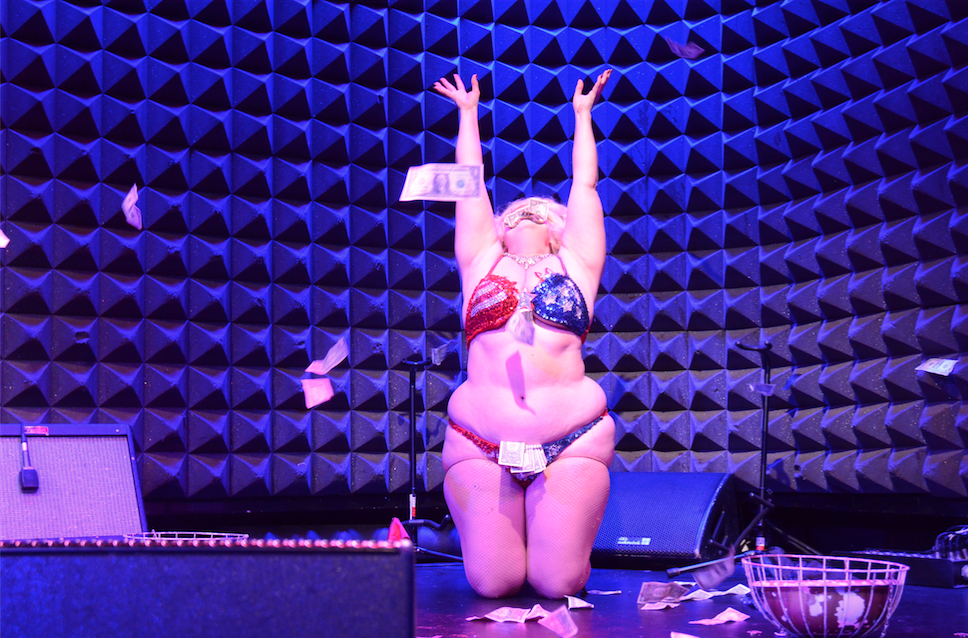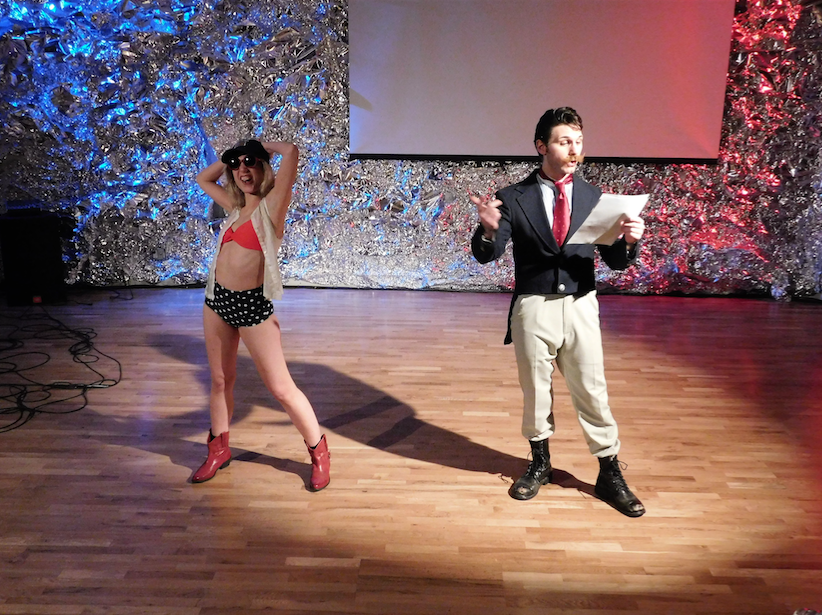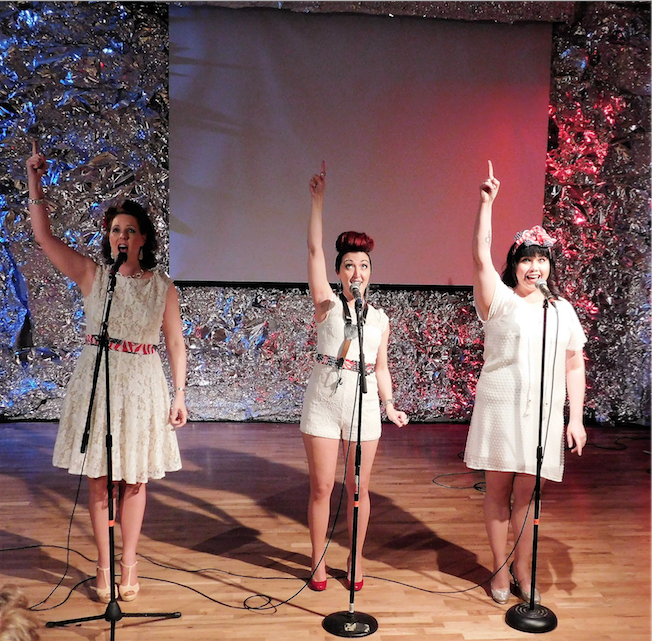U.S.O.ver: How Performing Protest Became Endurance Art
On January 20, 2017, the United States changed regimes in a revolution I had been dreading since the election results were announced. Like so many others I had set out with a group of artists to resist the change and on the night before the inauguration. The first U.S.O.ver event – a performance/protest/party – was staged at the secret venue Rubulad in Bushwick. Amidst the punk music, performance art, burlesque, cheap whiskey, dancing, and screams, a precious community formed among the artists and the crowd. In the Wonderland-esque setting, people traded information to travel together to the DC Women’s March and the event proceeds were donated to the ACLU. It was clear that night that live art could engender practical change.
Previous: Burlesque legend Dirty Martini performs her Patriot Act where her scales of justice are tipped by money and she reveals herself ‘proud to be an American’ consumed by lust for the dollar. U.S.O.ver, Joe’s Pub at The Public Theater. Photographed by Sohaila Mahjour. Above: Allison Brzezinski and Patrick Scorese perform as their despicable U.S.O.ver hosts. U.S.O.ver as part of Bad and Nasty’s Not-My-President’s Day festival. JACK in Brooklyn. All photographs by Kaitlin Nemeth.
Since that first performance I have worked with my partner Allison Brzezinski, as well as arts producers Amy Surratt, Kate Moran, and Chad Anthony Miller to curate five U.S.O.ver events. Each one had a fresh lineup at a new venue. U.S.O.ver came to be a subversion of the traditional USO Camp Shows, turning patriotic pageants into dissident vaudevilles of performance art, music, video art, and burlesque.
I should mention, that our original intention was to create performance events so extreme and sincere in their abject Americanism that audiences would be delighted by the absurdity and enraged by its familiarity. The curatorial vision was not one of clownish distortion, simply of excess. If the winning dictum was to make us “great again” then U.S.O.ver would conjure what that terrifying “greatness” was/is. Of course, that “great” is a pipe dream. The terrible abuses enacted during U.S.O.ver would all be executed with such a sparkling, gosh-darned, Great-White-Way-ish optimism that audiences’ stomachs would drop. Ideas for acts included tearful love songs to unmanned drones, ‘Blue Lives Matter’ kick lines, and other tasteless bits. Perhaps outraged audience members might stop the show and exit, high on adrenaline, to use their newly discovered agency against actual oppressors. I daydreamed that on the walk from the performance they’d call their senators or google the nearest protest.
However, that U.S.O.ver never happened, nor could it. Instead the performing artists insisted on conjuring safe spaces where the audience and we could laugh at our fears together.
However, that U.S.O.ver never happened, nor could it. Instead the performing artists insisted on conjuring safe spaces where the audience and we could laugh at our fears together. They were reluctant (especially in the early days of 2017) to enact atrocity like I requested. The trauma was too fresh. They needed to perform their resistance. I advocated for presenting the despicable and living our resistance offstage, but this was easier said than done. More important to me was curating artists, not their work, and thus allowing them freedom to create what and how they needed. As a straight whit male, it is especially important that I surrender my ego and trust in giving space for open collaboration.
As a result, U.S.O.ver took shape as a breathtaking multiplicity of diverse acts in different styles with intimate, personal perspectives. The series was structured like cabarets with music, drinks, a surprise bill of live art, and each show was hosted by a duo drunk off gallons of the “America First’ Kool-Aid, (a vestige of the original project conceit played by Brzezinski and myself). These two characters struggled to maintain control of the show as each artist asserted defiance through their work. At one performance Chris Tyler, à la Reaganite cowboy, danced to a Shania Twain medley, punched neo-nazis, and embodied resistance. At another, the musician Hwarg live-composed feedback loops of the president’s soundbites until they formed a screaming echo chamber that could only be dispersed by the audience’s enlisted shouts. Julie Atlas Muz, performing a legendary act with her vagina personified as a Rastafarian singer, serenaded us to a video montage from the Bush years. Watching her footage of Dick Cheney and the invasion of Iraq I was horrified by history’s cyclical progression.
Hotsy Totsy, take vintage songs and transform them into rousing protest anthems. U.S.O.ver as part of Bad and Nasty’s Not-My-President’s Day festival. JACK in Brooklyn.
James Scruggs performed excerpts from Kim Davies’ delightful play Miss Authenticity where Scruggs depicts a white girl celebrating her woke-ness à la Lena Dunham and absolving the spectators of their privilege because they’re “trying.” Scruggs, who is tackling the United States’ history of racism through his own multimedia series 3/Fifths, later commented, “Live performance can be effective as an instigator to inspire people to think outside of the realm they are used to. Performance can take incredibly complex ideas, concepts, events and present aspects of them in ways that audience can access.” So when artists like Scruggs, Tyler, Tigger!, and more gather for U.S.O.ver to perform a glimpse of their worldview, it gives one a glimpse of a truly American landscape. Audiences always rallied behind the performers.
Tigger! “The Godfather of Neo-Boylesque” performs The Emperor’s New Striptease, an elegant fan dance where, unbeknownst to the emperor, he is completely naked from the start. U.S.O.ver as part of Bad and Nasty’s Not-My-President’s Day festival. JACK in Brooklyn.
U.S.O.ver transformed with each artist and audience that comes into contact with it. This beautiful present-ness of contemporary performance art is what makes it a divergent and expressive tool against toxic nostalgia. However, it’s most successful on a personal/local scale. So if live art cannot incite revolt (due to numbers and to limitations of the medium) then perhaps it can still energize and rejuvenate, can bolster morale without being escapist or normalizing the actions of the enemy. Brzezinski, who is also the founder of Nasty Women Unite Fest, recalls that “audiences come up to us and thank us and share the ways in which they feel inspired to resist” after U.S.O.ver events. “The main goal is not to have our message be insular…in some ways it’s necessarily about numbers, it is about level of impact and we are making an impact little by little.”
***
2017 was an endless series of winded half-victories that ultimately crumbled into the travel ban, tax reform, deficits, and censorships. But it was also long months of hard-won education. ‘A year later and what’s next?,’ we ask like good art makers. Too many people pining for the Midterm elections – but we all know it will take more than that. And, with a gnarled 2018 tightening around us, we must be smart about our expressions of resistance. Many artists are making work, but perhaps not enough are working together. After a year in New York City, U.S.O.ver will take to the road – to Leslie County, Kentucky, or Holt County, Nebraska, or even Washington DC. While we’re there, we will be inviting residents to join us. Not performing at them – making art with them. That would make for some very interesting work. After all, it’s about making an impact little by little, playing the long game. It’s all endurance art now.
Related articles:
Election Editorial: Setting the Stage for the 2017 Battleground, Annabel Keenan, January 2017.
Election Editorial: “I am Not Giving Up and Neither Should You,” Madeleine Löfberg, November 2016.
Election Editorial: Forms of Resistance to Protect You From Heartbreak, Anna Mikaela Ekstrand, November 2016.
What's Your Reaction?
Guest Contributor, Cultbytes (formerly Patrick Scheid) is a writer, performance-based artist, and historiographer. He produces the U.S.O.ver performance series and his original works have been presented in galleries, museums, theaters, bars, parks, and street corners throughout New York City. His writing can be found in Ex Nunc, The Clyde Fitch Report, Culturebot, Queen Mob’s Teahouse, Emergency INDEX: An Annual Document of Performance Practice, Vol. 6, and more. l website linternationally at the British Film Institute, UK; MoMA PS1 Theater, USA; Cervantes Institute, Brazil; Ateliê da Imagem, Rio de Janeiro, Brazil; Cine 13 Paris, France; Berlin Biennale, Berlin, Germany; and most recently at the Colorado Photographic Arts Center. l twitter l contact l






